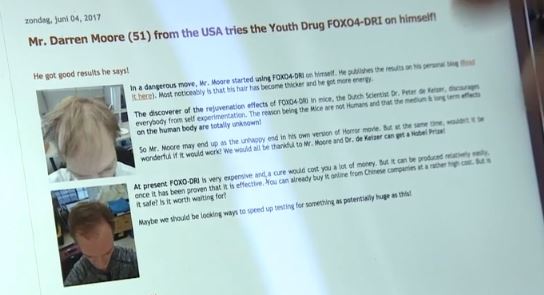I previously wrote about FOXO4 in a post in March 2017 that covered Dr. Peter de Keizer and his groundbreaking findings. In brief, interference via a newly created modified FOXO4-p53 peptide caused senescent cell apoptosis (death) in mice. Subsequently, the mice became younger and healthier. Most importantly, the mice regrew thick and robust coats of fur.
In the above study, the FOXO4 peptide was created in a D-retro inverso (DRI)-isoform conformation and named FOXO4-DRI. The anti-aging and hair growth related findings of this work were widely covered by the media in 2017. Dr. Keizer thereafter started his own biotech company called Cleara Biotech.
Senescent Cells
I have written about senescent cells (undesirable) and senolytics a number of times in the past. In an interview with Dr. de Keizer, he mentioned the following:
“If you remove the senescent cells, it means the (neighboring) stem cells can differentiate again, supporting tissue rejuvenation.”
Also make sure to read my related post on NAD, NMN and Resveratrol for aging reversal.
Hyperbaric Oxygen Treatment
Earlier this week, an anti-aging breakthrough from Israel was widely covered in the media. Apparently, giving pure oxygen to older people while in a hyperbaric chamber increased the length of their telomeres by 20 percent. More details here.
This development is impressive because it resulted in both:
- Telomere Elongation. And:
- Senescent Cell Reduction.
There have already been other methods via which people have increased their telomere length, including TA-65, exercise, diet and caloric restriction. However, this new hyperbaric oxygen treatment (HBOT) protocol led to elongation of telomeres at higher rates in comparison to existing interventions.
Using FOXO4 for Hair Growth
I was not planning to write about the above findings from last week as there did not seem to be any connection to hair loss.
However, earlier today, reader “egghead” posted a new link to the same story. More importantly, he made an astute observation in regards to the video at the bottom of the just mentioned Aljazeera link. He watched it entirely, and found an example of hair growth from FOXO4-DRI in the second half of the video.
Unfortunately, I cannot embed the video here, but below is the most relevant screenshot:

FOXO4-DRI
Apparently, many people have been taking commercially available versions of the FOXO4-DRI peptide. Both for longevity reasons and, in rare cases, for hair growth. The above screenshot is from someone named Darren Moore whose foxoddri website is no longer active. However, you can still read this article about his before and after hair growth.
Although Darren initially regrew his hair and it became darker, it seems like he lost most of the gains per this interesting 2019 video about him. During a brief perusal of Darren’s blog, I noticed that several commentators posted that they saw darker and fuller hair when taking FOXO4-DRI. There is also a 29-page group buy thread on this subject on the longecity forum.
I am surprised that people trust this untested and expensive chemical. Who knows if there are any long term side effects. In an interview on Linkedin, Dr. Keizer stated the following:
“We have now also received emails from people from America, for example, who have already bought the drug, the anti-aging substance FOXO4-DRI. You can now get it on the market in China. For a thousand euros you can buy ten milligrams and that is enough for a third of one treatment.”
I am not sure how the product that Dr. Keizer and his team developed (and patented) can be replicated by these Chinese labs. Even some US companies sell FOXO4-DRI for “scientific research use”. I assume all commercial versions of the drug have minor differences.
My Thoughts
I would not take this product in the hopes of re-growing my hair. Too little anecdotal evidence for that as of right now. Not to mention that the price for a full dose treatment is quite prohibitive. However, this whole FOXO4 subject matter is worth following in the coming years.
In an e-mail, Dr. Keizer told me that they were certainly not going to ignore hair growth results during their future research. However, cancer treatment and anti-aging remain their top priorities.
Perhaps localized senescent cell destruction in the scalp region will be possible via topical products in the future? Maybe this could then regrow hair via enabling nearby hair cells to function properly again?